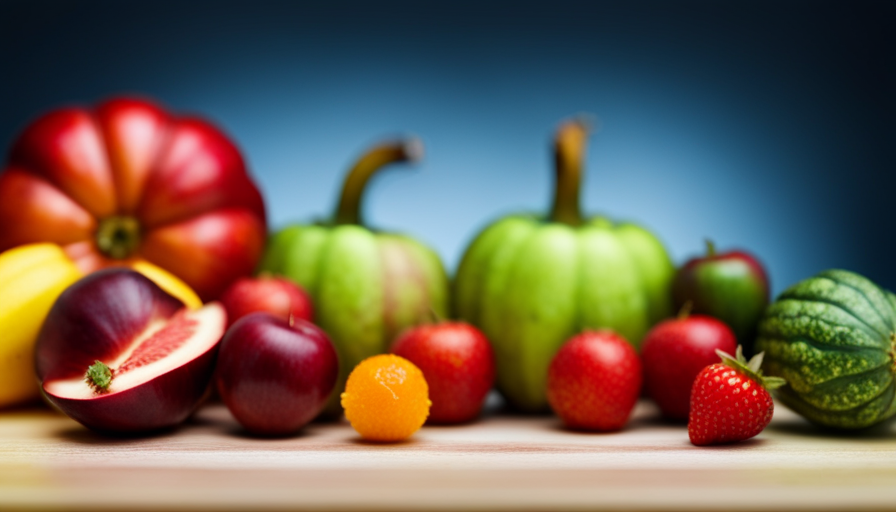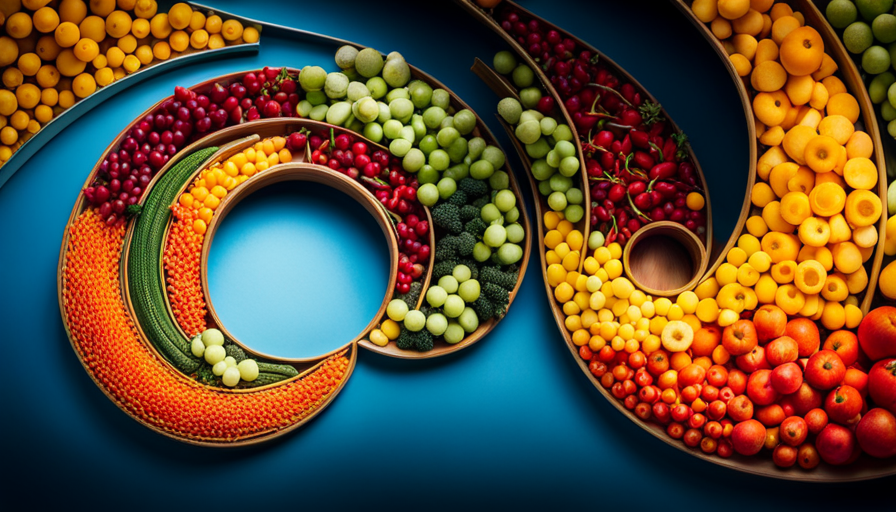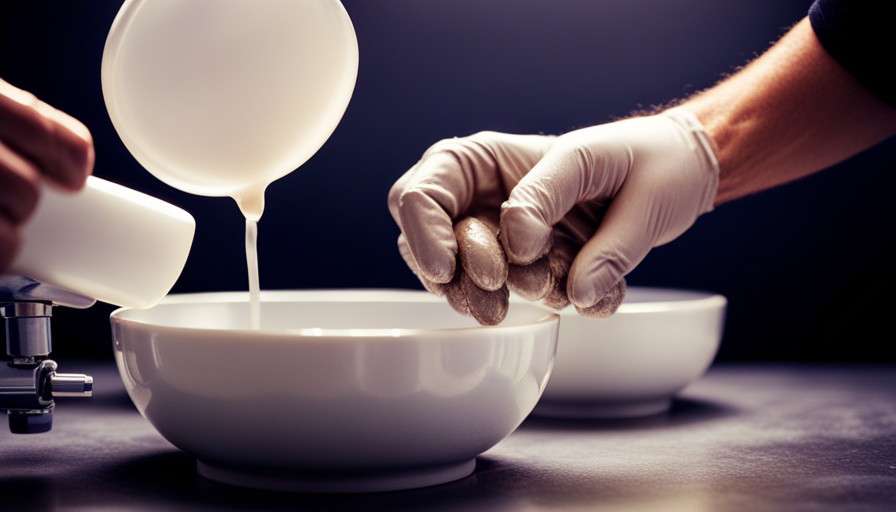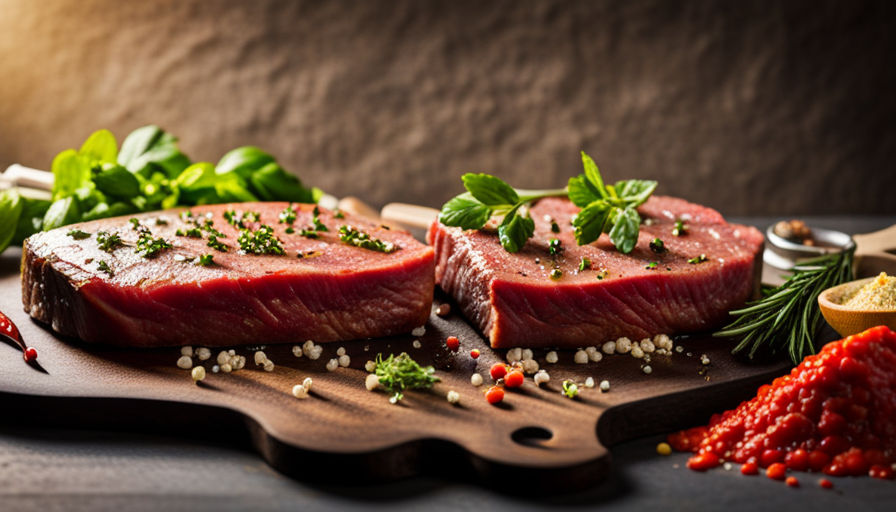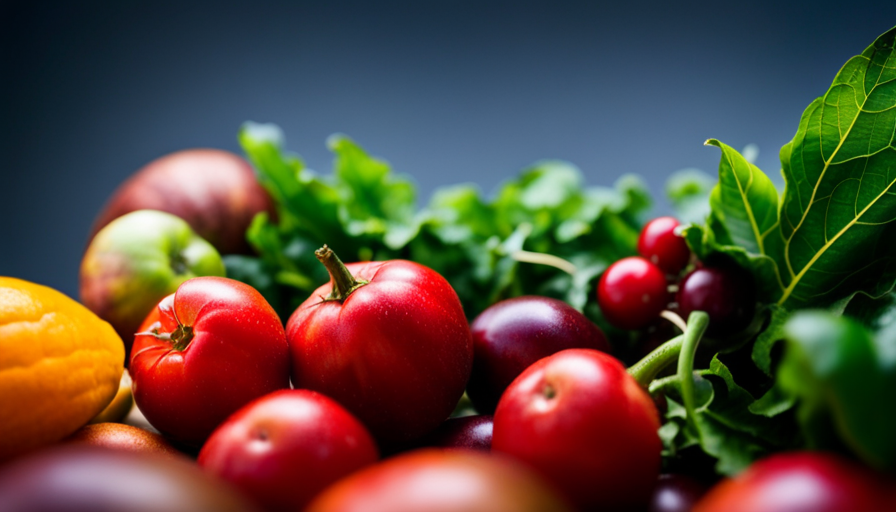Picture a scenario in which you effortlessly lose unwanted weight while savoring tasty and flavorful meals. A place where you feel lively, energized, and self-assured in your own body. Welcome to the world of raw food weight loss.
In this article, I will guide you through the ins and outs of this transformative journey, revealing the secrets to shedding those extra pounds quickly and effectively. By adopting a raw food diet, you can tap into the power of nature’s bounty, nourishing your body with vibrant, unprocessed foods that promote weight loss and overall well-being.
But don’t worry, this isn’t just another fad diet. Raw food weight loss is backed by science and has been proven to yield remarkable results. So, if you’re ready to embark on a life-changing adventure, let’s dive in and discover how quickly you can lose weight by embracing the raw food lifestyle.
Key Takeaways
- Raw food weight loss promotes satiety and reduces calorie intake, allowing for a calorie deficit.
- Transitioning to a raw food diet involves incorporating raw fruits, vegetables, nuts, and seeds into meals and snacks.
- Protein intake in a raw food diet can be obtained from legumes, seeds, and sprouted grains.
- Fruits and vegetables are essential in a raw food diet as they are rich in vitamins, minerals, and antioxidants, promoting weight loss and overall health.
Benefits of a Raw Food Diet for Weight Loss
The incorporation of a raw food diet has been shown to provide numerous advantages for individuals aiming to lose weight. One of the key benefits of a raw food diet for weight loss is its ability to promote satiety and reduce calorie intake. Raw foods, such as fruits, vegetables, nuts, and seeds, are typically high in fiber and water content, which helps you feel fuller for longer and prevents overeating.
Additionally, raw foods are rich in nutrients and low in calories, allowing you to consume larger portions without consuming excessive calories. Moreover, a raw food diet can lead to long-term success in weight loss. By eliminating processed and high-calorie foods, you can create a calorie deficit, which is essential for shedding pounds. This diet also encourages the consumption of whole, unprocessed foods, which are more nutrient-dense and can support overall health and well-being.
Furthermore, the raw food diet promotes a sustainable and balanced approach to eating, focusing on whole foods rather than restrictive measures. This can lead to lasting lifestyle changes and improved weight management. Understanding the basics of a raw food diet is crucial for successful weight loss. Transitioning to a raw food diet involves incorporating a variety of raw fruits, vegetables, nuts, and seeds into your meals and snacks. It is important to ensure that you’re meeting all your nutritional needs and consulting with a healthcare professional or nutritionist for guidance.
Understanding the Basics of a Raw Food Diet
When it comes to understanding the basics of a raw food diet, I believe it’s important to focus on three key points.
First, this diet emphasizes eating primarily uncooked fruits, vegetables, nuts, and seeds, which are rich in nutrients and enzymes.
Second, it involves avoiding processed and cooked foods, as they can lose vital nutrients during the cooking process.
Lastly, incorporating raw food preparation techniques, such as juicing, blending, and sprouting, can help enhance the nutritional value and digestibility of the foods we consume.
Eating primarily uncooked fruits, vegetables, nuts, and seeds
By incorporating primarily uncooked fruits, vegetables, nuts, and seeds into your diet, you’ll be amazed at how quickly you can shed those extra pounds. Raw food weight loss is not only effective but also a healthy way to achieve your weight loss goals. Raw foods are rich in nutrients, enzymes, and fiber, which can help boost your metabolism and promote weight loss. Additionally, raw food recipes offer a wide variety of delicious options that can keep you satisfied and prevent you from feeling deprived. A raw food detox can also help kickstart your weight loss journey by eliminating toxins from your body. By avoiding processed and cooked foods, you can further enhance your weight loss efforts and improve your overall health.
Avoiding processed and cooked foods
Ditching processed and cooked foods is like breaking free from a tasteless prison, unlocking a world of vibrant flavors and nourishment for your body. Here are three reasons why avoiding processed and cooked foods can be beneficial for weight loss on a raw food diet:
-
Increased nutrient intake: Raw foods retain more vitamins, minerals, and enzymes compared to their cooked counterparts. This nutrient density supports weight loss by providing essential nutrients while keeping calorie intake in check.
-
Improved digestion: Raw foods are rich in dietary fiber, which aids digestion and promotes regular bowel movements. This helps prevent bloating and keeps the digestive system functioning optimally.
-
Reduced calorie consumption: Raw foods are typically lower in calories than processed and cooked foods. By focusing on raw fruits, vegetables, nuts, and seeds, you naturally consume fewer calories, leading to weight loss.
Transitioning to incorporating raw food preparation techniques is the next step in maximizing the benefits of a raw food diet.
Incorporating raw food preparation techniques
Unlock a world of vibrant flavors and nourishment for your body by embracing the art of raw food preparation techniques. Raw food recipes offer a plethora of options to create delicious and nutritious meals that support your weight loss journey.
By incorporating raw food meal planning into your routine, you can enjoy a variety of fruits, vegetables, nuts, and seeds in their natural state, preserving their essential nutrients and enzymes. Raw food preparation techniques include methods such as blending, juicing, dehydrating, and sprouting.
These techniques allow you to create refreshing smoothies, flavorful salads, crunchy snacks, and even raw desserts. With a little creativity and experimentation, you can discover a whole new world of culinary possibilities.
In the next section, we’ll explore how rapid weight loss can be achieved on a raw food diet, building upon the foundation of incorporating raw food preparation techniques.
Rapid Weight Loss on a Raw Food Diet
With the speed of a cheetah chasing its prey, shedding pounds rapidly on a raw food diet is achievable. If you’re looking to lose weight quickly, here are four key points to consider:
-
Potential risks of rapid weight loss on a raw food diet: While losing weight rapidly may seem tempting, it’s important to be aware of potential risks. Rapid weight loss can lead to muscle loss, nutrient deficiencies, and a weakened immune system. It’s crucial to consult with a healthcare professional before embarking on any extreme weight loss program.
-
The role of detoxification in rapid weight loss on a raw food diet: Raw food diets are often associated with detoxification. By consuming whole, unprocessed foods, you provide your body with essential nutrients and antioxidants that support detoxification processes. However, it’s important to note that rapid weight loss may not necessarily be a result of detoxification alone, but rather a combination of factors such as reduced calorie intake and increased physical activity.
-
Monitoring nutrient intake: While rapid weight loss can be achieved on a raw food diet, it’s essential to ensure you’re still meeting your nutritional needs. Raw food diets often require careful planning to ensure an adequate intake of nutrients such as protein, iron, calcium, and vitamin B12. Consider consulting with a registered dietitian to develop a well-balanced meal plan.
-
Maintaining a balanced raw food diet: While rapid weight loss may be your initial goal, it’s important to transition into a sustainable and balanced raw food diet. Focus on incorporating a variety of fruits, vegetables, nuts, seeds, and whole grains to ensure you’re getting a wide range of nutrients. Remember, weight loss is a journey, and maintaining a healthy weight involves long-term lifestyle changes.
Transitioning into the subsequent section about maintaining a balanced raw food diet, it’s crucial to continue making informed choices to support your overall health and well-being.
Maintaining a Balanced Raw Food Diet
When maintaining a balanced raw food diet, it’s important to ensure sufficient protein intake for optimal health and muscle repair. This can be achieved by incorporating protein-rich foods such as legumes, seeds, and sprouted grains.
Additionally, healthy fats from sources like avocados and nuts should be included to support brain function and nutrient absorption.
Lastly, incorporating a variety of fruits and vegetables is crucial for obtaining essential nutrients like vitamins, minerals, and antioxidants that are necessary for overall wellbeing.
Ensuring sufficient protein intake
To ensure you’re getting enough protein while on a raw food weight loss journey, it’s important to incorporate a variety of plant-based sources like legumes, nuts, and seeds into your diet. These protein sources not only provide essential amino acids, but they also offer other nutrients like fiber, vitamins, and minerals.
Here are four examples of protein-rich foods to include in your raw food diet:
-
Lentils: These legumes are a great source of plant-based protein, containing approximately 18 grams of protein per cooked cup.
-
Almonds: With about 6 grams of protein per ounce, almonds are a convenient and nutritious snack option.
-
Chia seeds: These tiny seeds pack a punch, offering around 4 grams of protein per ounce, along with omega-3 fatty acids and fiber.
-
Hemp seeds: Another seed option, hemp seeds provide about 9 grams of protein per ounce and are rich in essential fatty acids.
Including healthy fats from sources like avocados and nuts will complement your protein intake and support overall health and weight loss goals.
Including healthy fats from sources like avocados and nuts
Ensuring sufficient protein intake is crucial for a successful raw food weight loss journey, but it’s equally important to include healthy fats in your diet. Avocados and nuts are excellent sources of these essential fats. They not only add a rich and creamy texture to your meals, but they also provide a range of nutritional benefits.
Avocados are packed with heart-healthy monounsaturated fats, fiber, vitamins, and minerals. They can be used in various recipes, from creamy dressings to smoothies and even as a spread on raw crackers.
Nuts offer a good dose of healthy fats, protein, and important nutrients like vitamin E and magnesium. Incorporating avocados and nuts into your raw food diet not only enhances the flavors, but it also promotes satiety and provides essential nutrients.
Next, let’s explore the importance of incorporating a variety of fruits and vegetables for essential nutrients.
Incorporating a variety of fruits and vegetables for essential nutrients
Including a variety of fruits and vegetables in my diet is essential for obtaining a wide range of essential nutrients and overcoming the misconception that raw food diets lack variety and flavor. Fruits and vegetables are rich in vitamins, minerals, and antioxidants that support overall health and well-being. They provide a variety of nutrients such as vitamin C, vitamin A, potassium, and fiber, which are crucial for maintaining a healthy weight and promoting weight loss. Moreover, consuming a diverse array of fruits and vegetables can add excitement and flavor to my meals, making the raw food diet an enjoyable and sustainable choice. Here is a table showcasing the nutrient content of some common fruits and vegetables:
| Fruit/Vegetable | Nutrient Content |
|---|---|
| Avocado | Healthy fats |
| Spinach | Iron, calcium |
| Blueberries | Antioxidants |
| Bell peppers | Vitamin C |
| Carrots | Vitamin A |
By incorporating a variety of fruits and vegetables, I can not only benefit from a wide range of nutrients but also enhance my weight loss journey. Transitioning into the next section, it is important to also consider the importance of portion control.
The Importance of Portion Control
By watching your portion sizes, you can visualize the power of controlling how much food you put on your plate and ultimately imagine the pounds melting away. Portion control is a crucial aspect of a raw food weight loss journey. When it comes to losing weight, it’s not just about what you eat, but also how much you eat.
Portion control offers several benefits. Firstly, it helps you create a calorie deficit, which is essential for weight loss. By reducing the amount of food you consume, you naturally consume fewer calories.
Secondly, portion control allows you to enjoy a variety of foods without overindulging. Instead of restricting yourself to certain foods, you can have a little bit of everything in moderation. This helps prevent feelings of deprivation and increases the sustainability of your weight loss journey.
There are various strategies you can employ to practice portion control. One effective method is to use smaller plates and bowls. This tricks your brain into thinking that you’re eating a full meal, even if the portion size is smaller.
Another strategy is to measure your food using tools like measuring cups or a food scale. This helps you become more aware of appropriate portion sizes. Additionally, listening to your body’s hunger and fullness cues can guide you in determining the right amount of food to eat.
By incorporating portion control into your raw food weight loss plan, you can effectively manage your calorie intake and achieve your goals. As you move forward, it’s important to also focus on staying hydrated on a raw food diet.
Staying Hydrated on a Raw Food Diet
Stay mindful of your hydration levels on a raw food diet to keep your body feeling refreshed and energized throughout the day. Maintaining hydration is crucial for overall health and well-being, especially when following a raw food diet.
Raw fruits and vegetables naturally contain high water content, which can contribute to your daily fluid intake. However, it’s important to remember that water needs can vary from person to person, depending on factors such as activity level and climate.
To ensure you stay properly hydrated on a raw food diet, it’s best to follow some simple practices. First, try to drink at least eight glasses of water per day. This will help replenish any fluid loss and keep your body functioning optimally. Additionally, consider incorporating hydrating foods into your meals, such as watermelon, cucumber, and leafy greens.
It’s also important to listen to your body’s signals of thirst, as this can indicate a need for more fluids. Pay attention to any signs of dehydration, such as dry mouth, fatigue, or dark urine, and take immediate action to rehydrate.
Maintaining hydration is crucial when following a raw food diet. By incorporating best practices such as drinking enough water, consuming hydrating foods, and listening to your body’s needs, you can ensure optimal hydration levels.
Transitioning into the subsequent section about combining a raw food diet with exercise, it’s important to consider the role of hydration in supporting physical activity.
Combining Raw Food Diet with Exercise
Get ready to experience a surge of energy and skyrocket your fitness levels by combining a raw food diet with exercise. When it comes to losing weight on a raw food diet, exercise is a crucial component. Not only does it help to burn calories, but it also enhances the effectiveness of the diet itself.
Here are three key aspects to consider when combining a raw food diet with exercise:
-
Cardiovascular exercises: Engaging in activities such as running, cycling, or swimming can help to increase your heart rate and burn significant calories. These exercises are particularly effective for weight loss on a raw food diet since they promote overall fat burning.
-
Strength training: Incorporating weight lifting or bodyweight exercises into your routine helps to build lean muscle mass, which boosts your metabolism. This is important on a raw food diet as it can help prevent muscle loss while losing weight.
-
Flexibility exercises: Activities like yoga or Pilates can improve flexibility, posture, and balance. They also promote relaxation and reduce stress, which are important factors for overall well-being on a raw food diet.
By combining these different types of exercises, you can maximize the benefits of your raw food diet and accelerate weight loss. Remember to listen to your body and adjust your exercise routine as needed. This will ensure that you continue to progress towards your weight loss goals while maintaining a healthy and balanced lifestyle. Transitioning into the next section about monitoring progress and adjusting as needed, it’s important to stay mindful of your body’s response to the diet and exercise regimen.
Monitoring Progress and Adjusting as Needed
When it comes to monitoring my progress on a raw food diet, I find it helpful to track my weight loss and body measurements regularly. This allows me to see the gradual changes and stay motivated along the way.
Additionally, assessing my energy levels and overall well-being helps me determine if any adjustments need to be made to my raw food diet. For example, I may need to incorporate more protein or increase my calorie intake.
It’s important to listen to my body and make necessary tweaks to ensure I’m getting the most out of this lifestyle change.
Tracking weight loss and body measurements
Imagine stepping on the scale each morning, eagerly watching the numbers decrease as you effortlessly shed pounds and inches from your body while following a raw food diet. Tracking weight loss and measuring progress are crucial for staying motivated and ensuring that you are on the right path towards your weight loss goals. One effective way to do this is by keeping a record of your weight and body measurements. By tracking these numbers over time, you can see the progress you are making and make adjustments to your diet or exercise routine if needed. To help you visualize your progress, here is a table that you can use to track your weight, waist circumference, and body fat percentage:
| Date | Weight (lbs) | Waist Circumference (inches) | Body Fat Percentage |
|---|---|---|---|
By regularly tracking these measurements, you can see how your body is changing and adjust your raw food diet accordingly. As you continue on your journey, it is important to also assess your energy levels and overall well-being.
Assessing energy levels and overall well-being
After successfully tracking weight loss and body measurements, it’s important to assess our energy levels and overall well-being during the raw food weight loss journey.
Rapid weight loss can sometimes lead to low energy levels and feelings of fatigue. Therefore, it’s crucial to maintain a balanced diet that includes adequate protein intake, healthy fats, and portion control.
Additionally, staying hydrated and incorporating regular exercise into our routine can contribute to our overall well-being.
Monitoring our progress and tracking weight loss allows us to make necessary adjustments to our diet and ensure long-term sustainability. Managing challenges along the way is essential for success.
In the next section, we’ll explore making adjustments to the raw food diet as necessary, ensuring continued progress towards our weight loss goals.
Making adjustments to the raw food diet as necessary
To keep up with the raw food diet, we can make adjustments as needed. For example, we can incorporate more plant-based protein sources like tofu or tempeh for added satisfaction and nutrients. Making modifications to our approach allows us to ensure we’re getting all the essential nutrients our bodies need while still enjoying the benefits of a raw food diet.
Here are some ways to adapt our approach:
-
Experiment with different raw food recipes to keep meals interesting and avoid boredom.
-
Gradually increase the amount of raw food in our diet to prevent digestive discomfort.
-
Listen to our body’s cues and make adjustments accordingly, such as incorporating cooked foods if necessary.
-
Seek guidance from a nutritionist or dietitian to ensure we’re meeting our nutritional needs.
By making these adjustments, we can successfully navigate the challenges and temptations that may arise on our raw food weight loss journey.
Transitioning into the next section, it’s important to manage these challenges to maintain long-term success.
Managing Challenges and Temptations
When you’re faced with challenges and temptations, don’t let them derail your raw food weight loss journey – instead, embrace them as opportunities to strengthen your willpower and commitment to your health goals. Managing cravings and navigating social situations can be tough, but with the right strategies, you can stay on track.
One effective way to manage cravings is to identify the underlying cause. Are you truly hungry, or are you just bored or stressed? By addressing the root cause, you can find healthier alternatives to satisfy your cravings. For example, if you’re craving something sweet, reach for a piece of fruit instead of a sugary snack.
In social situations, it’s important to plan ahead. Bring your own raw food dish to parties or gatherings, so you have something healthy to eat. If there aren’t any raw options available, focus on the raw fruits and vegetables that may be offered. Remember, it’s okay to politely decline food that doesn’t align with your goals.
Table: Strategies for Managing Challenges and Temptations
| Challenge | Strategy |
|---|---|
| Cravings | Address the root cause and find healthier options |
| Social situations | Plan ahead and bring your own raw food dish |
| Focus on raw fruits and vegetables |
By successfully managing challenges and temptations, you can maintain your raw food weight loss journey and transition into the next section about long-term sustainability and maintenance.
Long-Term Sustainability and Maintenance
Sustaining your healthy lifestyle long-term is essential for maintaining your progress and achieving lasting results. After all, it’s not just about reaching your weight loss goals; it’s about keeping the weight off and enjoying a healthy life for years to come.
To ensure long-term success and maintain a healthy lifestyle, here are three important strategies to consider:
-
Establish a balanced routine: Creating a routine that includes regular exercise, nutritious meals, and self-care activities can help you establish healthy habits that will last. Make sure to prioritize activities that you enjoy and that fit well into your daily schedule.
-
Surround yourself with support: Having a strong support system can make a significant difference in your long-term success. Seek out friends, family members, or even online communities that share your goals and can provide encouragement and motivation when challenges arise.
-
Focus on gradual changes: Instead of adopting extreme diets or making drastic changes, focus on making small, sustainable changes over time. This approach allows for a more realistic and manageable transition to a healthy lifestyle, increasing the chances of long-term success.
Remember, maintaining a healthy lifestyle is a lifelong journey. By incorporating these strategies and staying committed to your goals, you can achieve long-term success and enjoy a healthier, happier life.
Frequently Asked Questions
Can I eat cooked food occasionally while following a raw food diet for weight loss?
Occasionally indulging in cooked food while following a raw food diet for weight loss can be a challenge, but it’s not impossible. To satisfy your cravings, try exploring cooked food alternatives that are still nutritious and align with your weight loss goals. Opt for steamed vegetables or lightly grilled protein sources. Remember, moderation is key.
To stay on track with your raw food diet, focus on incorporating more raw food options and exploring different preparation techniques.
Can a raw food diet help improve digestion and gut health?
A raw food diet can potentially improve digestion and gut health. Raw foods are rich in enzymes, fiber, and probiotics that aid in digestion and promote a healthy gut microbiome. Additionally, consuming raw foods can have positive effects on mental and skin health. The abundance of nutrients and antioxidants found in raw fruits and vegetables can support brain function and contribute to a clear and glowing complexion.
Is it necessary to count calories on a raw food diet for weight loss?
Counting calories on a raw food diet may not be necessary for weight loss. Research shows that the quality of food matters more than the quantity. Processed foods, high in additives and preservatives, can hinder weight loss efforts.
However, a raw food diet consisting of whole, unprocessed fruits, vegetables, and nuts can naturally regulate calorie intake, leading to weight loss. Focus on nourishing your body with nutrient-dense foods instead of obsessing over calorie counting.
Can a raw food diet help reduce cravings for unhealthy foods?
A raw food diet can definitely help reduce cravings for unhealthy foods. By focusing on whole, unprocessed fruits, vegetables, nuts, and seeds, you provide your body with essential nutrients and fiber that can support overall health and satiety.
Incorporating a variety of colorful and nutrient-dense foods into your raw food diet meal plan can help satisfy cravings while nourishing your body. This is just one of the many raw food diet benefits that can contribute to a healthier lifestyle.
How can I ensure I’m getting enough protein on a raw food diet for weight loss?
To ensure I’m getting enough protein on my raw food weight loss journey, I can incorporate various plant-based sources into my diet. Foods like nuts, seeds, legumes, and leafy greens are all rich in protein.
Additionally, I can consider adding protein-rich supplements such as spirulina or hemp protein powder.
It’s important to maintain a balanced and varied diet to meet my protein needs while following a raw food approach.
Does the Timing of Meals on a Raw Food Diet Affect Weight Loss?
The timing of raw food diet meals can indeed affect weight loss. Eating smaller, more frequent meals throughout the day can help to keep metabolism high and reduce the likelihood of overeating. It’s important to listen to your body and eat when you’re truly hungry, regardless of the time.
Conclusion
In conclusion, embarking on a raw food diet for weight loss can yield rapid results. By understanding the basics and maintaining a balanced approach, you can achieve your weight loss goals effectively. Combining this diet with regular exercise further enhances the benefits.
Monitoring your progress and making necessary adjustments along the way ensures continued success. However, managing challenges and temptations can be a hurdle. The key lies in long-term sustainability and maintenance. So, are you ready to experience the transformative power of a raw food diet?

